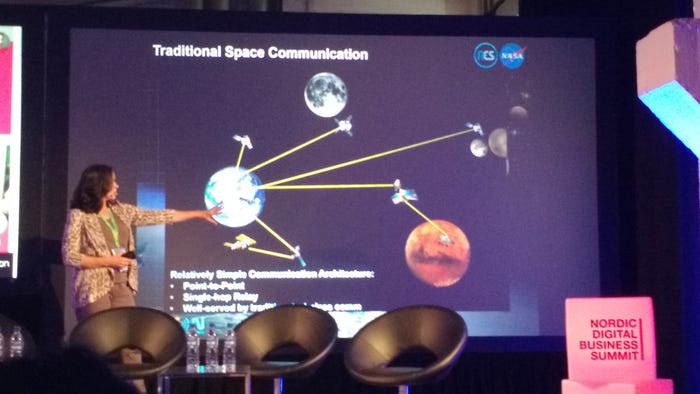NASA says connectivity is more than a #firstworldproblem
Speaking at the Nordic Digital Business Summit, NASA’s Brenda Lyons outlined how the team are planning to truly democratize the internet by bringing connectivity to the third world.
September 23, 2016

Speaking at the Nordic Digital Business Summit, NASA’s Brenda Lyons outlined how the team are hoping to democratize the internet by bringing connectivity to the third world.
Along with incorrect names on Starbucks orders and Waitrose running out of kale, internet connectivity has long been ridiculed as a first world problem. What would we do if we couldn’t catch up on the latest episode of ‘Keeping Up with the Kardashians’ or let people know that we’re at Heathrow on the verge of boarding a plane to Ibiza? But the story of internet connectivity has expanded in recent years, with numerous businesses and emergency protocols dependent on consistent and reliable internet access.
Now internet connectivity is no longer in the same bracket as a 15 second delay on Sky Sports coverage of the second test, but it is still viewed a first world problem. Mainly because we’re the ones who complain the loudest and receive the attention of the multi-nations chasing opportunities to reverse the erosion of profits. Despite claims from various multi-nationals that bringing internet connectivity to every person on the planet is a priority, many of the worlds’ poorest nations are still experiencing vast under-investment on communications infrastructure.
NASA has something to say about that however. Lyons, who heads up the Human Exploration and Operations Mission Directorate at the space agency, proposes the Solar System Internet could be the solution to connectivity challenges in some of the worlds’ poorest nations.
Communication in space relies on a relatively simple process with data being transferred over a number of relay stations on its way back to the command centre. For example, data collected at an asset on Mars would be sent to a satellite, which would then be forwarded to the command centre on Earth. For this to be achieved, each rally point would have to conduct a ‘digital handshake’ to ensure there is an end-to-end connection. Only when there is an end-to-end connection, can the data be transferred. Common Internet Protocol assumption do not apply in space. The images below outline this.


The problem lies in disruptions. Data is not transmitted when the connection is broken, meaning it can be lost should the network connection be timed-out. Should the connection be re-established prior to the time-out condition being activated, the data will continue on its journey back to Earth, though latency then becomes an issue. Think of a reverse Swiss Cheese model. When all the holes align, data is a go, when they aren’t everything grinds to a halt. It’s not massively efficient, it can lead to significant delays on the delivery of the data, or even huge amounts of data being lost during the transmission.
Lyons’ work is currently surrounding the development of DTN, the Delay/Disruption Tolerant Network. It’s a simple concept, but one which is providing to be quite revolutionary in the NASA communications programme.
When data is ready to be transmitted, it is transferred to the first available relay point. If the second relay point is not available, it is stored, removing the risk of lost data should the network time-out condition be met. Once the next relay point is available, the data is transferred, and so on. The ability to ‘data hop’ between relay stations can be drawn out to numerous relay stations, improving the resiliency of data transfer, and more often than not, reducing latency. In short, the delivery of the data may not be instantaneous, but the store-and-forward mechanism does guarantee it.
This is all well and good in space, but what are the Earthly opportunities? Consider areas where connectivity is inconsistent, unreliable or weak. For example, an emergency services vessel at sea or third world countries where internet access may only be available for an hour a day. In instances where connection-rich networks are uncommon, financially unfeasible or environmentally impossible, the ability to ‘hop’ data between relay points when connections are available could provide the opportunity for the delivery of internet and communications services in non-emergency instances.
To make things more attractive, it’s also cheaper as DTN does not really on consistent connectivity, and the underlying infrastructure which could prove too costly for developing nations to invest in.
So, while multi-nationals around the world are promising the delivery of the internet to every person on the planet while simultaneously finding more important (and lucrative) projects in developed nations, the NASA team is actually doing something about it. Nice one.
About the Author
You May Also Like










.png?width=300&auto=webp&quality=80&disable=upscale)


_1.jpg?width=300&auto=webp&quality=80&disable=upscale)